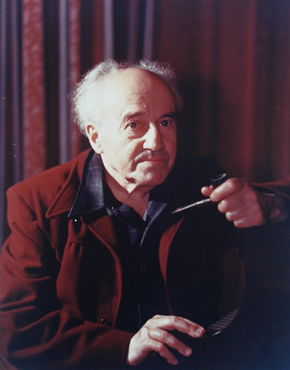|

Complexity of Thought
Eugene Feygelson and Malcolm Troup
play Beethoven and Bloch,
reviewed by MALCOLM MILLER
A Beethoven Piano Society of Europe recital of music by the two Bs might have signified any number of permutations of Bach, Brahms or Boulez. For their admirably well attended lunchtime concert at London's St Martin-in-the-Fields on 19 December 2008, the young American violinist Eugene Feygelson and BPSE Chairman Malcolm Troup chose to couple the violin sonatas of Beethoven with Bloch, a composer whose works -- some fifty years after his death -- are still far too unfamiliar to general and even specialised audiences. The launch of a new International Ernest Bloch Society (with Charles Mackerras as president) and its projected Festival of Bloch in 2009 are therefore initiatives to be warmly applauded, offering audiences far and wide the chance to reappraise the oeuvre of this 20th century master in all its richness, spanning his many styles, including Swiss, French, American and Jewish, his instrumental and stage works including the large scale opera Macbeth (to be revived by UCL Opera).

Ernest Bloch
|
Bloch's Violin Sonata of 1920 is a monumental work -- each of its three powerful movements is almost an entire Act of an imaginary operatic drama, full of emotional intensity, passionate waves of energy and expression, and ravishing soundscapes that -- whilst redolent of the impressionist modern masters of his time -- also offer an individual personality that is replete with significance. There are several recordings available yet the chance to experience it in performance offers a first hand appreciation of the life force at the heart of Bloch's style. Eugene Feygelson, a performer and musicologist currently pursuing postgraduate studies at Cambridge folliowing his training at Eastman School of Music, Rochester, was very much upto the challenge of Bloch's idiom, his searching often dark tone finding just the right mood of solemnity or meditation, and the ability to rise in mercurially to silvery tension and striving. He was vibrantly supported by the swirling orchestral richness of Malcolm Troup's pianism, as, from the very start, the outpouring of cascading fountains of arpeggios in welling Ravelian peaks and troughs, and trilling ostinato pedals over which Feygelson's sustained melodic gestures counterpointed the surging bass melodies beneath.
One could imagine the work as a concerto with orchestra, such was the forceful voluptuousness of the piano writing, which, despite some occasions of overbalancing the violin's tone, Malcolm Troup evocatively realised with acrobatic energy, leaping across various registers, adding colour to Bloch's whole tone and bitonal harmonies, and dissonant chromaticism. The duo projected the drama and aggression of the first movement with conviction, the insistent three-note motif urgently emphasised by Feygelson eventually reaching -- via pregnant silences and pauses -- a final climactic cliff edge of possibility, then proceeding through a magisterial syncopated unison passage to the movement's arresting destination. Also elemental, almost primitive in passion, was the slow central movement which attained a more centred stillness in Feygelson's very first theme, sustained over Troup's delicate ostinato of spacious arpeggios. Here Bloch's complexity of thought emerged in the dialogues between the performers, their surging themes exchanged in canon, striving rhapsodically. The climax might have been more vividly capped by the violin yet Feygelson's focus and concentration always engaged one, drawing on the music's inner passion, and the movement's ending was especially magical, with the piano's unresolved sevenths providing an elusive halo over the violin's sustained tonus.
With renewed vitality the final movement displayed Bloch's distinctive use of extended harmonic stretches, which require careful colouring; Troup's leaping chordal accompaniment developed acrobatically heightening the dissonant syntax and if perhaps there was some overemphasis of the grandiose gesture, the energetic syncopation was galvanising. Bloch's voice was always to the fore -- right up to the final dialogue of falling third motifs between the instruments, which the piano then takes over to miraculously bring the whole work into a new stratosphere, high in the register. Feygelson and Troup were here alive to the epiphanic denoument, where, in its unexpected shift from minor to major, the expressive flow finds it point of stasis and fulfilment.
Their delicately classical account of Beethoven's Op 30 No 1 had much to commend it, and served to weld the ensemble through its scintillating exchanges, eloquent dialogues in the slow movement and characterful variations. The sometimes problematic balance due to the resonant acoustic and size of the piano makes it all the more pressing for the impressive duo to perform the work in a differently designed hall, which one hopes will form part of the manifold events of the Bloch 50th anniversary Festival in 2009, a Festival during which one hopes Bloch's chamber oeuvre, as well as his wider output, will attract new audiences and interpreters to the riches of his music.
Copyright © 27 December 2008
Malcolm Miller, London UK

|

